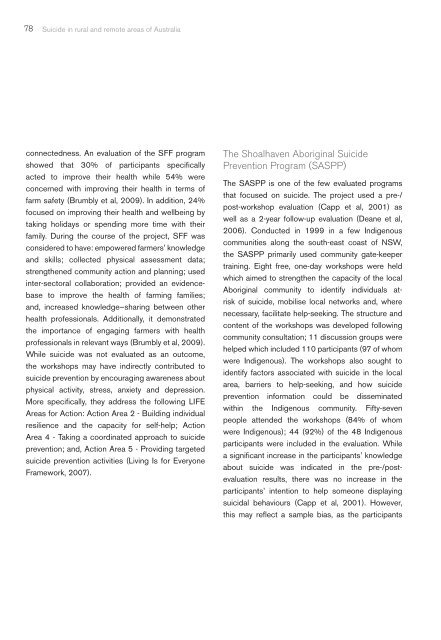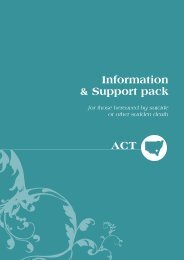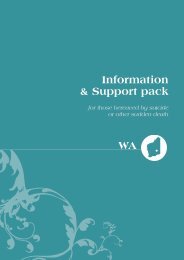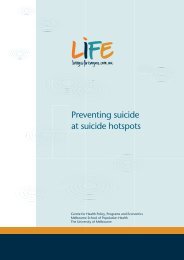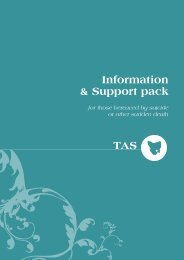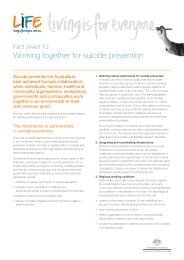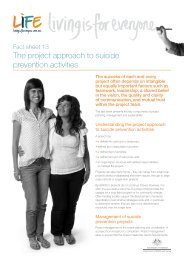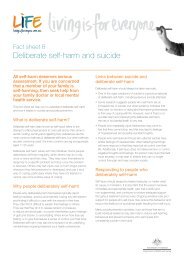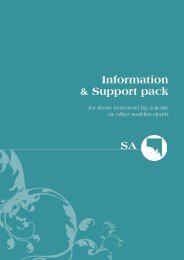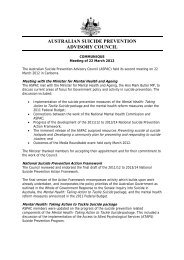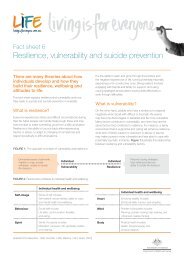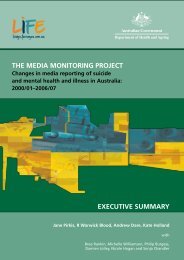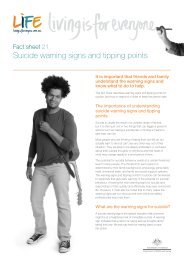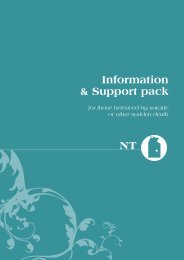SUICIDE in RURAL & REMOTE AREAS of AUSTRALIA - Living is for ...
SUICIDE in RURAL & REMOTE AREAS of AUSTRALIA - Living is for ...
SUICIDE in RURAL & REMOTE AREAS of AUSTRALIA - Living is for ...
You also want an ePaper? Increase the reach of your titles
YUMPU automatically turns print PDFs into web optimized ePapers that Google loves.
78<br />
Suicide <strong>in</strong> rural and remote areas <strong>of</strong> Australia<br />
connectedness. An evaluation <strong>of</strong> the SFF program<br />
showed that 30% <strong>of</strong> participants specifi cally<br />
acted to improve their health while 54% were<br />
concerned with improv<strong>in</strong>g their health <strong>in</strong> terms <strong>of</strong><br />
farm safety (Brumbly et al, 2009). In addition, 24%<br />
focused on improv<strong>in</strong>g their health and wellbe<strong>in</strong>g by<br />
tak<strong>in</strong>g holidays or spend<strong>in</strong>g more time with their<br />
family. Dur<strong>in</strong>g the course <strong>of</strong> the project, SFF was<br />
considered to have: empowered farmers’ knowledge<br />
and skills; collected physical assessment data;<br />
strengthened community action and plann<strong>in</strong>g; used<br />
<strong>in</strong>ter-sectoral collaboration; provided an evidencebase<br />
to improve the health <strong>of</strong> farm<strong>in</strong>g families;<br />
and, <strong>in</strong>creased knowledge–shar<strong>in</strong>g between other<br />
health pr<strong>of</strong>essionals. Additionally, it demonstrated<br />
the importance <strong>of</strong> engag<strong>in</strong>g farmers with health<br />
pr<strong>of</strong>essionals <strong>in</strong> relevant ways (Brumbly et al, 2009).<br />
While suicide was not evaluated as an outcome,<br />
the workshops may have <strong>in</strong>directly contributed to<br />
suicide prevention by encourag<strong>in</strong>g awareness about<br />
physical activity, stress, anxiety and depression.<br />
More specifi cally, they address the follow<strong>in</strong>g LIFE<br />
Areas <strong>for</strong> Action: Action Area 2 - Build<strong>in</strong>g <strong>in</strong>dividual<br />
resilience and the capacity <strong>for</strong> self-help; Action<br />
Area 4 - Tak<strong>in</strong>g a coord<strong>in</strong>ated approach to suicide<br />
prevention; and, Action Area 5 - Provid<strong>in</strong>g targeted<br />
suicide prevention activities (Liv<strong>in</strong>g Is <strong>for</strong> Everyone<br />
Framework, 2007).<br />
The Shoalhaven Aborig<strong>in</strong>al Suicide<br />
Prevention Program (SASPP)<br />
The SASPP <strong>is</strong> one <strong>of</strong> the few evaluated programs<br />
that focused on suicide. The project used a pre-/<br />
post-workshop evaluation (Capp et al, 2001) as<br />
well as a 2-year follow-up evaluation (Deane et al,<br />
2006). Conducted <strong>in</strong> 1999 <strong>in</strong> a few Indigenous<br />
communities along the south-east coast <strong>of</strong> NSW,<br />
the SASPP primarily used community gate-keeper<br />
tra<strong>in</strong><strong>in</strong>g. Eight free, one-day workshops were held<br />
which aimed to strengthen the capacity <strong>of</strong> the local<br />
Aborig<strong>in</strong>al community to identify <strong>in</strong>dividuals atr<strong>is</strong>k<br />
<strong>of</strong> suicide, mobil<strong>is</strong>e local networks and, where<br />
necessary, facilitate help-seek<strong>in</strong>g. The structure and<br />
content <strong>of</strong> the workshops was developed follow<strong>in</strong>g<br />
community consultation; 11 d<strong>is</strong>cussion groups were<br />
helped which <strong>in</strong>cluded 110 participants (97 <strong>of</strong> whom<br />
were Indigenous). The workshops also sought to<br />
identify factors associated with suicide <strong>in</strong> the local<br />
area, barriers to help-seek<strong>in</strong>g, and how suicide<br />
prevention <strong>in</strong><strong>for</strong>mation could be d<strong>is</strong>sem<strong>in</strong>ated<br />
with<strong>in</strong> the Indigenous community. Fifty-seven<br />
people attended the workshops (84% <strong>of</strong> whom<br />
were Indigenous); 44 (92%) <strong>of</strong> the 48 Indigenous<br />
participants were <strong>in</strong>cluded <strong>in</strong> the evaluation. While<br />
a signifi cant <strong>in</strong>crease <strong>in</strong> the participants’ knowledge<br />
about suicide was <strong>in</strong>dicated <strong>in</strong> the pre-/postevaluation<br />
results, there was no <strong>in</strong>crease <strong>in</strong> the<br />
participants’ <strong>in</strong>tention to help someone d<strong>is</strong>play<strong>in</strong>g<br />
suicidal behaviours (Capp et al, 2001). However,<br />
th<strong>is</strong> may refl ect a sample bias, as the participants<br />
GriffithBook FINAL 20/09.<strong>in</strong>dd 78<br />
15/11/12 4:28 PM


